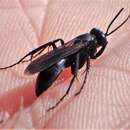Comprehensive Description
provided by Memoirs of the American Entomological Society
Pompilus (Arachnospila) arctus Cresson
Pompilus arctus Cresson, 1865, Proc. Ent. Soc. Phila., 4: 453 [Type: S, Colorado (ANSP, no. 554)]. — Cresson, 1867, Trans. Amer. Ent. Soc, 1: 92.
Psammochares anoplinus Banks, 1919, Bull. Mus. Comp. Zool., 63: 231-232 [Type: 2, Alberta: Medicine L. to Jasper, 4 July 1915 (J. C. Bradley) (CU, no. 683)]. Synonymy by Evans, 1951.
Pycnopompilus siouxensis Dreisbach, 1950, Amer. Midi. Nat., 43: 592, 593, 598 [Type: 8, Nebraska: Glen, Sioux Co., 13 Aug. 1906 (Univ. Nebraska)]. Synonymy by Evans, 1951.
Pycnopompilus sculleni Dreisbach, 1950, ibid., pp. 587, 594, 598 [Type: 8, Oregon: Cornucopia, 7100 feet, 25 July 1936 (HAS) (MCZ, no. 28, 382)]. Synonymy by Evans, 1951.
Pompilus (Arachnospila) arctus Evans, 1951, U. S. Dept. Agri. Monogr. 2, p. 935. — Evans, 1951, Trans. Amer. Ent. Soc, 77: 258-261. — Evans, 1956, Ent. News, 67: 10.
Pycnopompilus parvus Dreisbach, 1952, Amer. Midi. Nat., 48: 152-153 [Type: 8, Utah: Kelton, 24 Aug. 1949 (G. F. Knowlton) (USNM, no. 66, 587)]. Synonymy by Evans, 1956.
• Pompilus (Arachnospila) scelestus Cresson
A P. (AJ arctus Cresson
■ P. (A.) fumipennis eureka (Banks)
(all 3 spp. occur widely in U.S.)
Female. — Length 7.5-14.5 mm. Black; pubescence wholly dark, with obscure to fairly strong bluish reflections; fore wings moderately infuscated, darker apically; hind wings lightly infuscated, also darker apically. Scape without erect hairs; head, thorax, and propodeum otherwise moderately to rather densely hairy. Clypeus about 3 X as wide as high, its apical margin distinctly arcuately excised. MID .59-.63 X TFD; UID .75-.85 X LID; ocelli in approximately a right triangle, POL usually slightly less than OOL. Third antennal segment varying from .60 to 1.0 X UID. Front basitarsus with either three or four comb-spines, the spines varying from 1 to 3 X as long as the width of the basitarsus.
Male. — Length 6.5-12 mm. Black, inner and outer orbits often with small pale streaks; pubescence nearly always silvery on the front, sometimes on parts of the thorax; wings hyaline or lightly infuscated, with a darker outer marginal band. Scape not hairy, but front and vertex rather strongly hairy; propodeum with some strong erect hairs. Front broad, MID .60-.65 X TFD; UID subequal to or slightly greater or less than LID; POL usually less than OOL. SGP convex medially, toward the base with a pair of elevations which may be rounded or acute, sometimes barely evident. Genitalia with the parameres slender throughout; digiti smaller apically and with fewer setae than in the two following species (see fig. 191 in Evans, 1951).
Distribution. — This species ranges from Yukon and Labrador to Central Mexico and to Virginia. (Map 72.)
Mexican specimens examined. — 1 9,1 S . Hidalgo: 18,4
mi. W Pachuca, 16 June 1961 (KU Mex. Exped.) [KU]. Mexico: 1 5, Teotihuacan Pyramids, 6 July 1951 (HEE) [MCZ].
- bibliographic citation
- Evans, H.E. 1966. A Revision of the Mexican and Central American Spider Wasps of the Subfamily Pompilinae (Hymenoptera: Pompilidae). Memoirs of the American Entomological Society vol. 20. Philadelphia, USA

